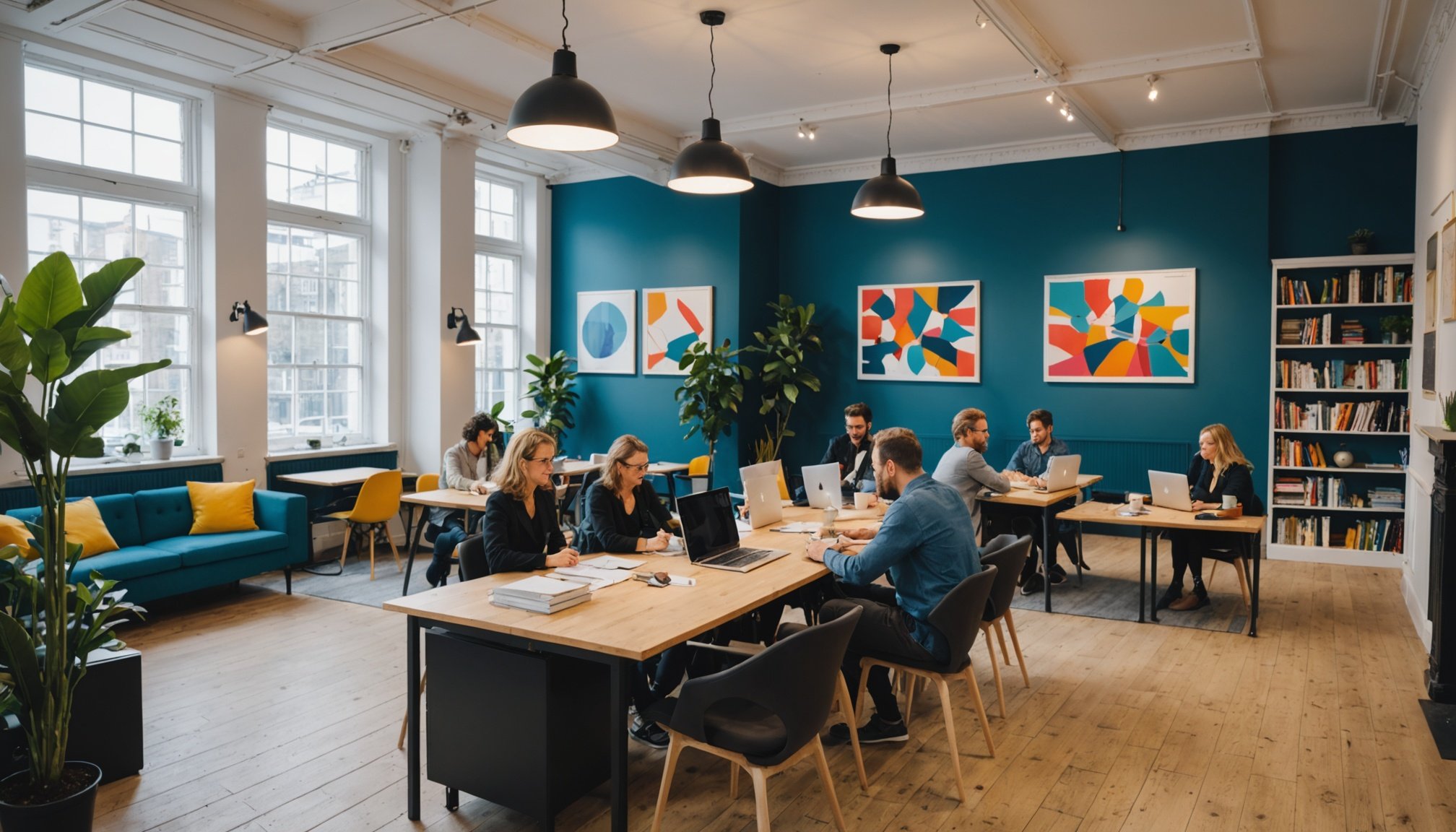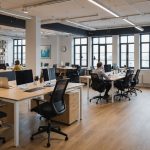Creating a Vibrant Creative Coworking Hub in the UK: A Comprehensive Guide
Understanding the Need for Flexible and Adaptive Coworking Spaces
In the modern workplace, flexibility and adaptability are key to fostering innovation and productivity. The rise of hybrid work models and the evolving needs of businesses have made it crucial for coworking spaces to be more than just a place to work; they need to be vibrant hubs that support various work styles and promote community engagement.
“As businesses grow, downsize, or evolve their operations, their space requirements often change. A flexible floor plan allows office layouts to adjust seamlessly without the need for costly renovations,” notes an article on flexible office floor plans[1].
Additional reading : Mastering urban agriculture: a comprehensive blueprint for building a successful farming collective in the uk
Choosing the Right Location
When establishing a coworking hub, the location is paramount. It should be easily accessible, centrally located, and offer a desirable environment that attracts a diverse range of professionals.
Key Considerations for Location
- Accessibility: Ensure the location is well-connected to public transportation and has ample parking options.
- City Amenities: Proximity to cafes, restaurants, gyms, and other amenities can enhance the overall work experience.
- Safety and Security: The area should be safe and secure, with 24/7 access for members.
- View and Ambiance: A location with a pleasant view or a vibrant ambiance can boost morale and productivity.
For instance, London, being a hub for various industries, offers numerous locations that can cater to different types of businesses. Areas like Shoreditch, Clerkenwell, and Soho are popular for their creative and innovative vibes[3].
Have you seen this : Comprehensive blueprint for launching a uk yoga retreat: your step-by-step pathway to health and safety certification
Designing the Workspace
The design of the coworking space is critical in creating an environment that is both functional and inspiring.
Key Elements of Workspace Design
-
Open Spaces and Modular Layouts:
-
Open floor plans foster collaboration and transparency.
-
Modular setups allow for quick rearrangement of spaces using mobile furniture, movable walls, and adaptable dividers[1].
-
Multipurpose Rooms:
-
Include rooms that can be easily adapted for different uses such as meetings, events, or training sessions.
-
These versatile spaces maximize utility and eliminate the need for additional real estate as business needs evolve[1].
-
Collaborative and Private Zones:
-
Balance teamwork and focus by integrating collaborative areas alongside quiet zones.
-
Collaborative spaces can double as temporary workstations or brainstorming hubs, while private areas offer employees a quiet place to focus or conduct virtual meetings[1].
Example: The GEM Factory of the Future
The Green Energy & Materials (GEM) Factory of the Future at the University of Maine is an exemplary model of flexible and adaptive design. This facility combines industrial aesthetics with modern functionality, featuring open spaces, multipurpose rooms, and collaborative zones. The design emphasizes visibility and transparency, fostering the free exchange of ideas and innovation[2].
Building a Strong Community
A thriving coworking hub is not just about the physical space; it is also about the community that inhabits it.
Strategies for Building Community
-
Host Events and Workshops:
-
Organize regular events, workshops, and networking sessions to bring members together.
-
This could include industry-specific conferences, skill-sharing sessions, or social gatherings[3].
-
Engage Members in Decision-Making:
-
Involve members in the design and operational decisions of the space.
-
This can be done through surveys, feedback sessions, or member committees to ensure the space meets the needs of its users[1].
-
Create Shared Spaces:
-
Include communal areas such as lounges, kitchens, and outdoor spaces where members can interact informally.
-
These spaces can serve as “mixing valves” for different professionals, fostering collaboration and innovation[2].
Integrating Technology and Sustainability
Future-proofing your coworking space involves integrating the latest technologies and embracing sustainable practices.
Technological Integration
-
Smart Office Systems:
-
Implement smart office systems that include features like automated lighting, temperature control, and security systems.
-
These systems can enhance efficiency and provide a seamless work experience[1].
-
Digital Collaboration Tools:
-
Incorporate digital whiteboards, video conferencing hubs, and other collaboration tools to support hybrid work models.
-
These tools can be seamlessly integrated into adaptable layouts, ensuring the space remains functional and efficient[1].
Sustainable Practices
-
Energy-Efficient Solutions:
-
Use energy-efficient lighting, natural ventilation, and sustainable materials in the construction and operation of the space.
-
These practices not only reduce environmental impact but also align with long-term sustainability goals[1].
-
Adaptive Use of Resources:
-
Design the space to adapt to changes in energy consumption and resource usage.
-
This could include using renewable energy sources or implementing recycling programs within the workspace[1].
Best Practices for Coworking Space Operators
To ensure the success and longevity of your coworking hub, it is essential to follow best practices in its operation and management.
Collaborating with Designers and Architects
- Work closely with experienced architects and designers to ensure the office layout is not only flexible but also functional and future-ready.
- These professionals can translate business needs into adaptable designs that support both current operations and long-term objectives[1].
Engaging Stakeholders
- Involve employees and other stakeholders in the planning process to gain valuable insights into how the office is used.
- This collaboration ensures the final design meets the needs of the workforce and fosters a sense of ownership among members[1].
Regularly Reviewing and Updating Office Layouts
- Periodically review and update office layouts to address emerging needs and optimize the workspace.
- This proactive approach allows companies to adjust to new technologies, operational shifts, and workforce demands without major overhauls[1].
Practical Insights and Actionable Advice
Here are some practical tips and actionable advice for establishing a vibrant creative coworking hub:
Membership Options
- Dedicated Desks: Offer dedicated desks for members who need a consistent workspace.
- Private Offices: Provide private offices for businesses or individuals requiring more privacy.
- Day Passes: Offer day passes for flexibility and to attract a broader range of users.
- Meeting Rooms and Conference Rooms: Ensure there are ample meeting rooms and conference rooms available for members to use[3].
Community Engagement
- Coworking Assembly Breakfast Show: Host regular breakfast shows or networking events to bring members together and discuss industry trends and challenges[3].
- Coworking Convos: Participate in or host virtual events like Coworking Convos to connect with other industry professionals and share best practices[3].
Technological and Sustainable Features
| Feature | Description |
|---|---|
| Smart Office Systems | Automated lighting, temperature control, and security systems |
| Digital Collaboration Tools | Digital whiteboards, video conferencing hubs |
| Energy-Efficient Lighting | LED lighting, natural ventilation |
| Sustainable Materials | Use of recycled materials, sustainable wood products |
| Renewable Energy Sources | Solar panels, wind energy integration |
| Recycling Programs | Implement recycling programs for paper, plastic, and other materials |
In the dynamic UK business landscape, adaptability is key to the success of any coworking hub. By prioritizing flexibility, scalability, sustainability, and technological integration, you can create a vibrant workspace that supports growth, innovation, and community engagement.
“Flexible office floor plans enable businesses to respond to changing circumstances, support growth, and create vibrant work environments that drive innovation and productivity,” emphasizes the importance of adaptable designs[1].
By following these guidelines and best practices, you can establish a coworking hub that not only meets the current needs of its members but also prepares them for the future of work.
Key Takeaways:
- Flexible Floor Plans: Accommodate evolving workforce needs and business requirements.
- Community Engagement: Host events, engage members in decision-making, and create shared spaces.
- Technological Integration: Incorporate smart office systems, digital collaboration tools, and sustainable practices.
- Regular Updates: Periodically review and update office layouts to optimize the workspace.
- Collaboration with Experts: Work closely with architects, designers, and stakeholders to ensure the space is functional and future-ready.
Investing in a well-designed and adaptable coworking space is a strategic move that supports business resilience and success in a competitive market.











